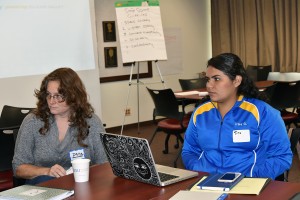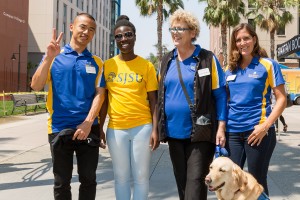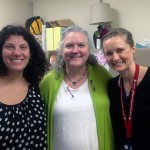
About two dozen students, faculty and staff members gathered on Sept. 9 to discuss how to expand mentor programs at San Jose State University.
Janelly Ruiz, a third-year justice studies student, said the first time she met Assistant Professor Faustina DuCros they discovered they had a lot in common. Ruiz did not meet with DuCros in class or through an advising center; she connected with the professor through a new program, mentorcommunity@sjsu, that is designed to pair students who are seeking a mentor with a committed volunteer from SJSU’s faculty or staff.
“I’m from Southern California, so I came up here on my own,” Ruiz said. “I am also a first-generation student, so my parents don’t know about or understand everything I am doing. I wanted a mentor I could share my experiences with.”
Ruiz selected DuCros from an online tool that helps to match students with a faculty member. DuCros had lived in Southern California and worked with legal aid, attributes that made Ruiz more comfortable reaching out to the faculty member.
“I was nervous to send the first message, and it did take a while for her to get back to me, but she finally did,” Ruiz said, adding that the first time they met in person they ended up talking for two hours.
Ruiz learned about mentorcommunity@sjsu through Adelante, the Chicanx/Latinx Student Success Task Force. A U.S. Department of Education Title III Strengthening Institutions five-year grant supports the pilot program. It is one of five initiatives a group of faculty and staff members is focusing on as sustainable best practices for student success.
“We want to provide support to students in the first two years of college,” said Pat Backer, the director of the grant program titled Project Succeed and a professor in the College of Engineering. “Many of our students are the first in their family to go to college, and they are not from traditional college-going backgrounds. They need to learn how to navigate the college environment.”
Maria Luisa Alaniz, a professor in the Sociology and Interdisciplinary Social Sciences department and faculty director, worked with Marlene Scherer Stern, the program coordinator who created an online mentor program and community at Stanford, to implement SJSU’s online pairing tool. The goal is to use high-tech tools to promote and increase high-touch mentoring opportunities and experiences. The two hosted a discussion session on Sept. 9 that was open to students, faculty and staff to find out what they believe is needed to expand the program beyond two pilot departments.
“We are doing this roll out very deliberately,” Alaniz said. “We want the program to be integrated into the campus culture. The only way to do that is using an incremental approach to ensure that we are integrating campus feedback as we develop the program.”
The group will be surveying campus community members to find out more about other existing mentor programs to discover how they can collaborate and foster mentorship on campus. A second discussion group will be scheduled in the spring.
In the meantime, Alaniz is visiting select classes within the two pilot departments to recruit students who will complete an orientation before creating a profile on the site. Faculty and staff from across campus are invited to sign up at https://mentorcommunitysjsu.
Ruiz, an intern with the program, is happy to share with interested students how the mentorship program helped her.
“It definitely gave me confidence to reach out to professors,” she said. “When I had other opportunities such as a faculty/student dinner, it gave me the confidence to take the initiative to attend.”
The mentorcommunity@sjsu program is one of several initiatives that Backer and her collaborators selected because they believed the programs could be sustainable once the grant period is completed. Other areas include block scheduling, peer educators and mentors, first-year experiences, and student living learning communities in the residence halls. The activities support SJSU’s Four Pillars of Student Success plan around student engagement and advising.
A discussion will also be held on first-year experience programs on Sept. 23. It will aim to answer questions about what type of programs are sustainable at SJSU, what will fit in with SJSU’s culture and what students want. Models could include a general education course, an extended orientation model, or programming in the dorms.
“We are looking at funding multiple models next fall,” Backer said. “We are interested in putting it together and running assessments to see which work and which don’t.”
Project Succeed Discussion Session
Brainstorming session on first-year experiences and its future at SJSU
Sept. 23, 11 a.m. to 2 p.m., in ENG 285
Lunch will be provided
RSVP at http://tinyurl.com/sjsu-



